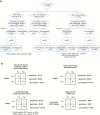Viral Surveillance in Serum Samples From Patients With Acute Liver Failure By Metagenomic Next-Generation Sequencing
- PMID: 29020199
- PMCID: PMC5848299
- DOI: 10.1093/cid/cix596
Viral Surveillance in Serum Samples From Patients With Acute Liver Failure By Metagenomic Next-Generation Sequencing
Abstract
Background: Twelve percent of all acute liver failure (ALF) cases are of unknown origin, often termed indeterminate. A previously unrecognized hepatotropic virus has been suspected as a potential etiologic agent.
Methods: We compared the performance of metagenomic next-generation sequencing (mNGS) with confirmatory nucleic acid testing (NAT) to routine clinical diagnostic testing in detection of known or novel viruses associated with ALF. Serum samples from 204 adult ALF patients collected from 1998 to 2010 as part of a nationwide registry were analyzed. One hundred eighty-seven patients (92%) were classified as indeterminate, while the remaining 17 patients (8%) served as controls, with infections by either hepatitis A virus or hepatitis B virus (HBV), or a noninfectious cause for their ALF.
Results: Eight cases of infection from previously unrecognized viral pathogens were detected by mNGS (4 cases of herpes simplex virus type 1, including 1 case of coinfection with HBV, and 1 case each of HBV, parvovirus B19, cytomegalovirus, and human herpesvirus 7). Several missed dual or triple infections were also identified, and assembled viral genomes provided additional information on genotyping and drug resistance mutations. Importantly, no sequences corresponding to novel viruses were detected.
Conclusions: These results suggest that ALF patients should be screened for the presence of uncommon viruses and coinfections, and that most cases of indeterminate ALF in the United States do not appear to be caused by novel viral pathogens. In the future, mNGS testing may be useful for comprehensive diagnosis of viruses associated with ALF, or to exclude infectious etiologies.
Keywords: SURPI computational pipeline; indeterminate ALF; metagenomic next-generation sequencing; pathogen discovery; viral hepatitis.
© The Author 2017. Published by Oxford University Press for the Infectious Diseases Society of America.
Figures


Comment in
-
Viruses Associated With Unexplained Acute Liver Failure: Next Generation Reveals the Last Generation.Clin Infect Dis. 2017 Oct 16;65(9):1486-1488. doi: 10.1093/cid/cix597. Clin Infect Dis. 2017. PMID: 29020151 No abstract available.
Similar articles
-
Acute Liver Failure of Indeterminate Etiology: A Comprehensive Systematic Approach by An Expert Committee to Establish Causality.Am J Gastroenterol. 2018 Sep;113(9):1319. doi: 10.1038/s41395-018-0160-2. Epub 2018 Jun 27. Am J Gastroenterol. 2018. PMID: 29946176 Free PMC article.
-
Enhanced Virus Detection and Metagenomic Sequencing in Patients with Meningitis and Encephalitis.mBio. 2021 Aug 31;12(4):e0114321. doi: 10.1128/mBio.01143-21. Epub 2021 Aug 31. mBio. 2021. PMID: 34465023 Free PMC article.
-
Clinical Outcome and Viral Genome Variability of Hepatitis B Virus-Induced Acute Liver Failure.Hepatology. 2019 Mar;69(3):993-1003. doi: 10.1002/hep.30279. Epub 2019 Feb 11. Hepatology. 2019. PMID: 30229977
-
[Viral hepatitis: molecular diagnosis].Praxis (Bern 1994). 1998 Oct 14;87(42):1381-8. Praxis (Bern 1994). 1998. PMID: 9824944 Review. German.
-
Yield and future issues of nucleic acid testing.Transfus Clin Biol. 2001 Jun;8(3):282-4. doi: 10.1016/s1246-7820(01)00115-x. Transfus Clin Biol. 2001. PMID: 11499978 Review.
Cited by
-
Benchmarking Metagenomics Tools for Taxonomic Classification.Cell. 2019 Aug 8;178(4):779-794. doi: 10.1016/j.cell.2019.07.010. Cell. 2019. PMID: 31398336 Free PMC article. Review.
-
Expansion of Betatorquevirus and/or Gammatorquevirus in Patients with Severe Clinical Outcomes of the Liver Diseases.Viruses. 2023 Jul 27;15(8):1635. doi: 10.3390/v15081635. Viruses. 2023. PMID: 37631978 Free PMC article.
-
Cutting-Edge Infectious Disease Diagnostics with CRISPR.Cell Host Microbe. 2018 Jun 13;23(6):702-704. doi: 10.1016/j.chom.2018.05.016. Cell Host Microbe. 2018. PMID: 29902435 Free PMC article.
-
Detection of Pulmonary Infectious Pathogens From Lung Biopsy Tissues by Metagenomic Next-Generation Sequencing.Front Cell Infect Microbiol. 2018 Jun 25;8:205. doi: 10.3389/fcimb.2018.00205. eCollection 2018. Front Cell Infect Microbiol. 2018. PMID: 29988504 Free PMC article.
-
Insights From Deep Sequencing of the HBV Genome-Unique, Tiny, and Misunderstood.Gastroenterology. 2019 Jan;156(2):384-399. doi: 10.1053/j.gastro.2018.07.058. Epub 2018 Sep 27. Gastroenterology. 2019. PMID: 30268787 Free PMC article. Review.
References
-
- Bernal W, Wendon J. Acute liver failure. N Engl J Med 2013; 369:2525–34. - PubMed
-
- Fagan EA. Acute liver failure of unknown pathogenesis: the hidden agenda. Hepatology 1994; 19:1307–12. - PubMed
-
- Lee WM, Brown KE, Young NS et al. ; Acute Liver Failure Study Group Brief report: no evidence for parvovirus B19 or hepatitis E virus as a cause of acute liver failure. Dig Dis Sci 2006; 51:1712–5. - PubMed
MeSH terms
Substances
Grants and funding
LinkOut - more resources
Full Text Sources
Other Literature Sources

